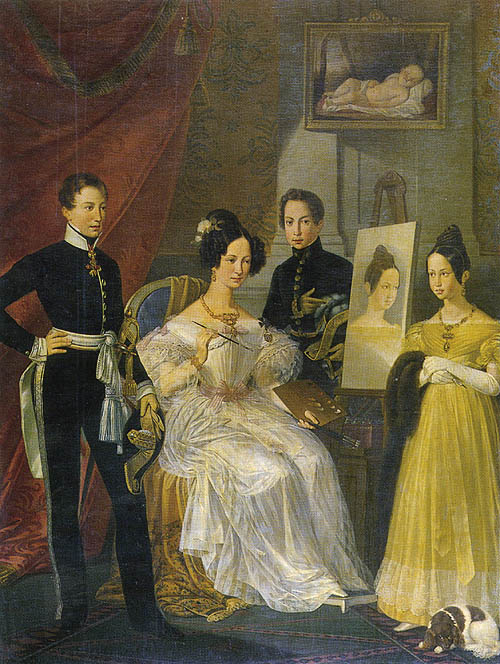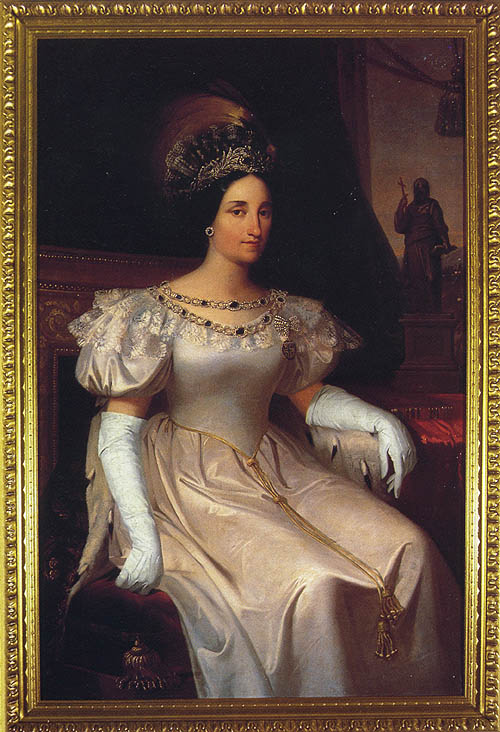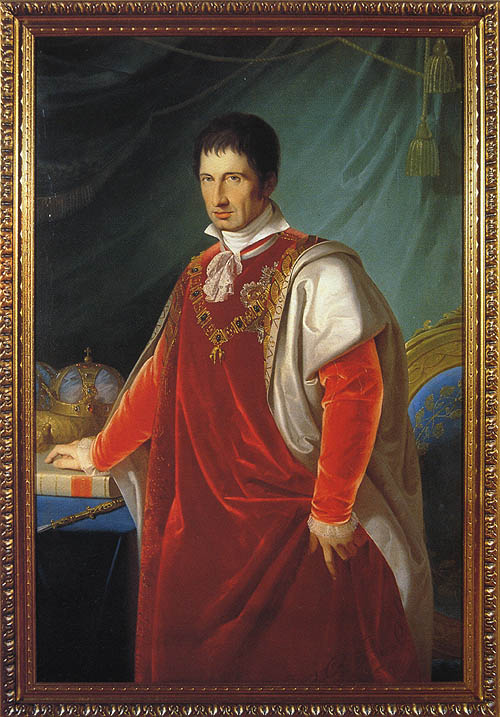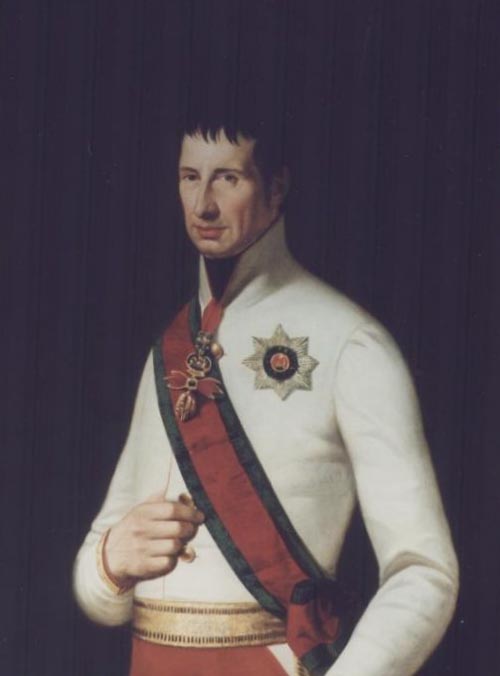 |
 |
 |
 |
 |
 |
 |
 |
 |
|
A Jacobite Gazetteer - Modena
Palazzo Ducale |
The palace was the birth place of Queen Mary Beatrice (wife of King James II and VII). In 1717 their son, King James III and VIII, stayed here for three days (March 12 to March 14). 1 From 1814 until her death in 1840 the palace was the official residence of Queen Mary III and II and of her family. From 1840 until 1859 the palace was the official residence of her son King Francis I and his family. Since 1863 the palace has been used as a military academy. 2 Guided tours arranged by the Ufficio Accoglienza Turistica del Comune are meant to be available every Sunday. In practice, however, it is exceedingly difficult to obtain entrance to the palace. The state apartments are on the first floor above ground along the eastern half of the front facade (the right side as one faces it from the piazza). The first room after the entrance passage is the Sala Colleoni where there are portraits of King Francis I's grandfather, Archduke Ferdinand Karl Anton Joseph of Austria-Este, and King Francis' uncle Archduke Maximilian of Austria-Este (owner of Schloss Ebenzweier). The next room, the Terza anticamera, contains a portrait wrongly identified on the label (in May 2006) as of Princess Maria Teresa Cybo. It is certainly not she, and is instead an oil portrait by Adeodato Malatesta of Queen Adelgunde. 3 Adelgunde wears a white dress and the sash and insignia of the Bavarian Order of Theresa. On her head she wears a silver laurel-leaf tiara with a jewel at the centre. Around her waist she wears a gold braid with several knots and tassels. The tiara and the gold braid are similar to those worn by Queen Mary III and II in the Malatesta portrait in the Sala di lettura
There is another portrait in the Terza anticamera which is wrongly identified on the label as Adelgunde; it shows a lady in a large red head-dress. Presumably it is of Princess Maria Teresa Cybo. Also in this room is a portrait of Duke Alfonso IV of Modena, father-in-law of King James II and VII. The next room is the Sala del Trono off which is the Salottino d'Oro, with magnificent gilt walls. Next to the Sala del Trono is the Sala di lettura. On the left wall of this room is a portrait of the four children of Queen Mary III and II painted in 1836 by Bernardino Rossi. 4 Francis wears a military uniform with a white and blue waste sash. Around his neck he wears the insignia of the Austrian Order of the Golden Fleece. In his left hand he holds a feluca. His brother Ferdinand is also in a military uniform and holding a feluca. Their sister Maria Theresa is seated painting her sister Maria Beatrice who stands at the right. Maria Teresa wears on her left shoulder the insignia of the Austrian Order of the Starry Cross. This work has been the subject of much misunderstanding as to the identies of both the artist and the subjects. 5 In the background of the portrait is a painting of a newborn child; it has been suggested that this represents a painting by Queen Mary III and II. 6
On the centre wall of the Sala di lettura is an oil on canvas portrait of Queen Mary III and II by Adeodato Malatesta. 7 Queen Mary is seated on an ermine cape and wears the insignia of the Austrian Order of the Starry Cross on her left shoulder. In the background is a statue of the allegorical figure of Faith, holding a cross and a Bible and with head and eyes veiled.
To the left of the portrait of Queen Mary is a matching oil on canvas portrait of her husband, Duke Francis IV of Modena, also by Adeodato Malatesta. 8 Francis wears the scarlet robes of a knight of the Austrian Order of the Golden Fleece. On the table to his right are two crowns, one of an archduke of Austria, the other of a duke of Modena and Reggio. His right hand rests on a bound copy of the Codice Estense, the code of law published in 1771 and restored by Francis IV in 1814.
Above the door leading from the Sala di lettura to the Mensa ufficiali is a second portrait of Duke Francis IV of Modena. He is dressed in the uniform of an officer of the Austrian Army with the red and green sash of the Order of Saint Stephen of Hungary. Around his neck he wears the insignia of the Austrian Order of the Golden Fleece.
It is also possible to visit two large rooms to the right of the Sala Colleoni - the Sala dello Stringa o di Psiche and the Sala d'Onore. To the left of the entrance passage is a corridor on the wall of which hangs an oil on canvas portrait by Adeodato Malatesta of the comte de Chambord, husband of Princess Maria Theresa, and brother-in-law of King Francis I. 9 The comte de Chambord stands on the balcony of the Palazzo Cavalli Gussoni (now Palazzo Franchetti) in Venice with the Church of Santa Maria della Salute on the other side of the Grand Canal in the background.
When Queen Mary III and II's husband, Duke Francis IV of Modena, was restored to his throne in 1814, he commissioned a new private apartment in the east wing of the palace overlooking the garden. 10 Today there is a military musem in the east wing of the palace. Here one can see the Sala Ovale which Duke Francis IV used as a dining room; it is now a hall of remembrance. Notes 1 Bryan Bevan, King James the Third of England: A Study of Kingship in Exile (London: Robert Hale, 1967), 98-99. 2 Cf. Albano Biondi, Il Palazzo Ducale di Modena: sette secoli di uno spazio cittadino (Modena: Panini, 1987), 327. 3 Adeodato Malatesa was born in Modena in 1806 and died in the same city in 1891. Between 1834 and 1852 he painted a number of portraits of different members of the Royal Family as well as paintings on other subjects for the Royal Family. The portrait is wrongly identified in Adeodato Malatesta, 1806-1891: Modelli d'Arte e di Devozione (Milano: Skira, 1998), 154, as King Francis' elder sister, Maria Theresa, comtesse de Chambord. The fact that the subject wears the sash and insignia of the Bavarian Order of Theresa proves that she is Adelgunde. One of Malatesta's daughters was named Adelgonda; it is reasonable to conclude that she was named in honour of Queen Adelgunde. 4 Bernardino Rossi was born in Cortile di Carpi in 1803 and died in Modena in 1865. Rossi painted several other works for Duke Francis IV of Modena; cf. Adeodato Malatesta: La Virtù delle Arti e l'Accademia Atestina (Modena: Vaccari, 1998), 132-133. 5 The painting is not infrequently wrongly ascribed to the more famous Adeodato Malatesta. Several sources describe the painting as of Queen Mary III and II and three of her children; cf. Adeodato Malatesta: La Virtù delle Arti e l'Accademia Atestina, 132, "'scena di conversazione' che rappresenta la duchessa Maria Beatrice di Savoia, dilettante di pittura, presso il cavaletto, attorniata dai figli Ferdinando, Francesco e Maria Teresa". There is a similarly inaccurate description in Adeodato Malatesta, 1806-1891: Modelli d'Arte e di Devozione, 131, and in Biondi, Il Palazzo Ducale di Modena, 272. The standing female figure is certainly not Maria Teresa (who was older than her brothers), but instead her sister Maria Beatrice. The seated female figure could be either Queen Mary or her elder daughter Maria Teresa - but if it is Queen Mary, then one would have to explain why a portrait would be painted of Queen Mary and her three younger children without her elder daughter. If it were Queen Mary, then it would be more likely that she would wear the bejewelled insignia of the Order of the Starry Cross which she wears in the portait by Malatesta now in the Sala di lettura instead of a much simpler insignia. 6 Cf. Biondi, Il Palazzo Ducale di Modena, 272. There is a painting of a young St. John the Baptist by Queen Mary in the Galleria Estense. 7 The portrait measures 137 cm high and 89 cm wide; it was painted in 1836. Cf. Adeodato Malatesta, 1806-1891: Modelli d'Arte e di Devozione, 128-130. 8 The portrait measures 136 cm high and 89 cm wide; it was painted in 1834. Cf. Adeodato Malatesta, 1806-1891: Modelli d'Arte e di Devozione, 130-132. 9 The portrait measures 100 cm high and 86.5 cm wide. Cf. Adeodato Malatesta, 1806-1891: Modelli d'Arte e di Devozione, 151-152. 10 Elena Corradini, "Pitture di primo Ottocento nel Palazzo Ducale", Stanze ottocentesche del Palazzo Ducale di Modena (Modena: Fondazione del Cassa Risparmio di Modena), 12. Several of these rooms were painted by Luigi Manzini whose portrait of King Francis I can be seen today in the Collegio San Carlo. Image 1 (Facade): © Noel S. McFerran 2006. Image 2 (Queen Adelgunde): "Grand Ladies" http://www.gogmsite.net/early_victorian_-_1837_-_18/subalbum-adelgunde-of-bavar/princess-adelgunde-auguste.html. Image 3 (The children of Queen Mary III and II): Mauro Bini, Gli Estensi: Seconda parte, La Corte di Modena (Modena: Il Bulino, 1999): 217. Image 4 (Queen Mary III and II): Adeodato Malatesta, 1806-1891: Modelli d'Arte e di Devozione (Milano: Skira, 1998): 130. Image 5 (Duke Francis IV of Modena): Adeodato Malatesta, 1806-1891: 131. Image 6 (Duke Francis IV of Modena): http://spazioweb.esercito.difesa.it/siti_scuole/modena/Modena/appartamento%20di%20stato/staffieri.htm. Image 7 (Henri, comte de Chambord): Adeodato Malatesta, 1806-1891: 152. |
|
This page is maintained by Noel S. McFerran (noel.mcferran@rogers.com) and was last updated August 3, 2014. |






